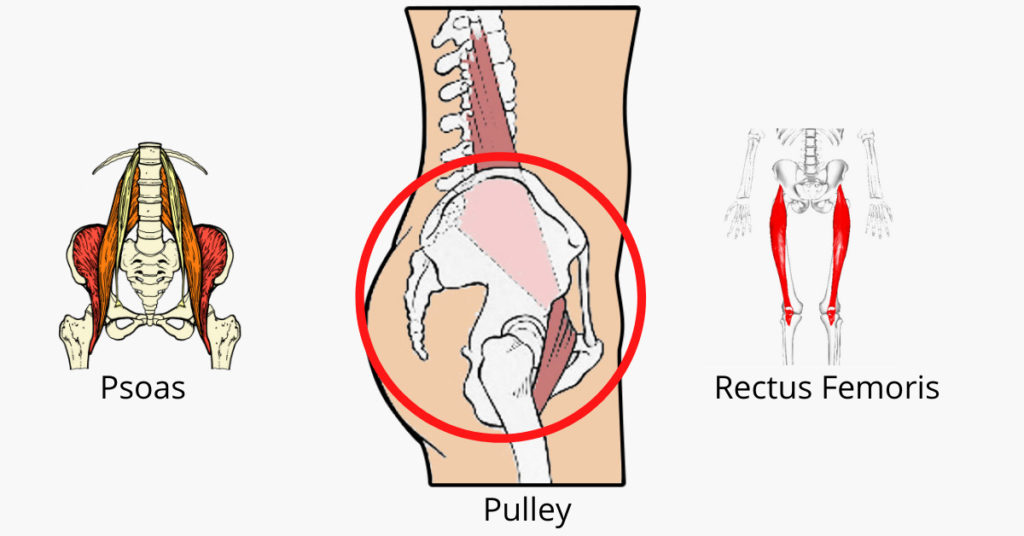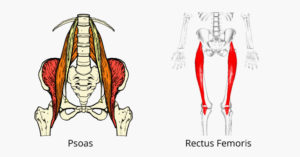The Rectus Femoris and the Psoas: A Troubled Relationship
The rectus femoris and psoas major are two of the body’s main hip flexors. The sartorius and tensor fasciae latae are others.
This suggests something pretty simple. Get your legs under your pelvis to make your body work better.
But now comes the explanation that might not be as easy to digest.
Let’s start with the psoas. I think the psoas major is the most important muscle in the body.
It walks us forward through life and it warehouses all of our unprocessed emotions. It also goes a long way to holding the spine upright on top of the pelvis.
The psoas connects in the front of the body along the lumbar spine and at the top of the leg.
The gluteus maximus and piriformis connect the legs to the spine from the back of the body.
These three muscles, when well aligned and functioning, help the spine stay vertical.
The rectus femoris is one of the four quadriceps muscles. The four quadriceps muscles all meet to insert into the tibia of the shin.
But the rectus femoris is the only one of these muscles that connect to the pelvis.
The others—vastus lateralis, medialis and intermedius—all connect to the femur or thigh bone.
The quadriceps is essentially an extensor of the knee, and only the rectus femoris plays a role in hip flexion.
Anyone who reads my blog knows that I am fairly obsessed with getting people to align their pelvis correctly.
In order for the pelvis to align correctly, the leg bones need to move directly under the hips.
This thigh alignment is key to getting the psoas to work as it is designed and for the rectus femoris to work successfully as a hip flexor.
The psoas acts like a pulley system in the body. A pulley is a simple machine. Viewed from the side, the hip bone is the pulley and the psoas is the rope.
The pulley work of the psoas facilitates muscle action that allows the extensor muscles of the spine to do their job.
The psoas is a pulley.
 The psoas can only act as a pulley if the legs are under the hips.
The psoas can only act as a pulley if the legs are under the hips.
If the legs are where they should be, the psoas move down from its origin at the base of the rib cage/top of the lumbar spine.
It moves forward to cross the rim of the pelvis and then moves back again. Then it inserts on the lesser trochanter, a knob of bone on the back half of the thigh.
It is the back/front/back arrangement that allows the psoas to help support the spine on top of the pelvis.
For this to happen the thighs have to be under the hips.
When the pelvis is misaligned and the thighs move forward they take the psoas with them. As a result, the tension across the rim of the pelvis is lost. Without tension, much of the psoas’ support capabilities dissipate.
When the thighs go forward a great deal of stress and pressure is put on the rectus femoris muscle.
And because the psoas has been taken out of the picture, the rectus femoris is called upon to support the upper body.
The rectus femoris tendon is really what bears the brunt of this powerful misalignment and rears its ugly head.
When someone refers to hip flexor problems they are likely talking about the tendon of the rectus femoris.
For many people, this manifests when they try to do core work when lying on the back.
Let’s say you are lying on the floor and try to take one or both feet off the ground. If something in your hip engages like a steel cable, that is the rectus femoris tendon.
I can even see this sometimes in private sessions.
When this tendon is over stretched and overburdened from the weight of the upper body sinking into it, it suffers.
And in this place of suffering, it can’t possibly do its main job of flexing the hip.
When the steel-cable-like thing happens it pretty much shuts down all attempts to either engage the quadriceps or work in concert with the psoas.
There is a pretty simple fix for this.
Get your legs under your pelvis and let the body start to work from a place of harmony and alignment.

